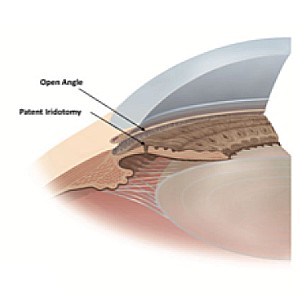Closed angle glaucoma
In this type of glaucoma the pressure is usually high, and it is this high pressure that causes damage to the optic nerve.
The “angle” is part of the drainage system of the eye and is where the iris meets the cornea and sclera. In closed angle glaucoma, the eyes natural drain system is blocked by the iris as can be seen in the image below. It is this blockage that causes the fluid inside the eye to build up causing a high pressure.
This condition can also present as an “acute attack” where the pressure goes up very rapidly. Symptoms for this range from severe eye pain, headache on one side, brow ache, blurring, whitening of vision, rainbow coloured haloes around lights, red eye, nausea and vomiting.
The symptoms usually last a few hours though rarely symptoms can last for a short time and resolve. Patients sometimes find these symptoms are worse at night and when reading. If concerned you should go to your nearest eye emergency service.
Depending on the pressure and the amount of nerve damage, treatments, range from laser iridotomy or cataract surgery. Sometimes cataract surgery is also combined with a procedure called goniosynechiolysis (this removes the iris from the drainage system). The ultimate aim of these treatments are to restore the natural drainage system of the eye.
If however the drainage system shows severe scarring then a procedure that bypasses the natural drainage system of the eye like a trabeculectomy may be necessary.
For more information on primary angle closure glaucoma a PDF from Glaucoma UK can be downloaded here.



